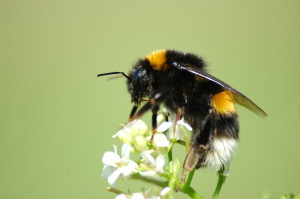What Can the Labial Gland of a Bee tell us About Using Fat?
In 1945, Fritz Albert Lipmann made a discovery that would earn him a share in the 1953 Nobel Prize for physiology or medicine. He (co-)discovered of Acetyl Co-enzyme A. Little did he know that seventy years after that discovery, we would find enzymes that use this co-factor in places as obscure as the genitals of an insect [1]. Less still did he expect bloggers to snigger inwardly whilst they wrote about it.
In fairness to him, it would be strange if he had. He was concerned with understanding how metabolism works, specifically, how energy is released from the chemical stores we rely upon. These are the mechanisms we have for both normal metabolism (being alive) and increased metabolism (exercise). It is fashionable at present for both sugars and fats, and the foods that contain them, to get a howlingly bad press in most of the increasingly obese western world. But how much do we know about the journey from 100 g of chips to a 4 kilometre run? Or to a bumblebee’s bollocks?
The energetic route is probably the better known bit. Chips, sliced potato deep-fried in vegetable oil, have about 180 calories per 100 g. That means, for the average 25 year old who weighs 70 Kg, 100 g of chips is enough to power a jog of just over 20 min. (I used the British Heart Foundation exercise calorie counter for these calculations, but there are others.)
Part of the gap between the eating and putting one leg in front of the other is called beta-oxidation and the overall chemistry of it is that it replaces the hydrogen on the carbons of the fats, with oxygen. It is the beginning of the process that turns the fat into carbon dioxide.
In beta-oxidation, the fatty acids bonded to coenzyme A are snipped into two-carbon units. The four-step process that does this leaves acetyl Co-A and another Co-A with the rest of the fatty acid on it each time. The snipping process is then repeated seven or eight times until the fatty acid has been used up—most fatty acids have 16 or 18 carbons. When used just for energy, these Acetyl Co-As are fed into the Electron Transport Chain, the final step of primary metabolism in which ATP, the ‘cash’ of energy provision in vivo is made. The citric acid cycle part of it is the one that releases the CO2, the organic product of the metabolism of fats.
Acetyl Co-A is more like the gold bullion of the internal biological energy market. It is not necessarily used for money, it can be used for other things. It can feed into secondary metabolism.
Acetyl Co-A is tremendously useful for secondary metabolism as the small 2-carbon units are inherently flexible building blocks. They can be used to make larger building blocks, such as isopentenyl pyrophosphate, IPP. This is where the preparation of sophisticated signalling molecules may enter from stage left, carried in a bee’s knickers. Specifically, 2,3-dihydrofarnesol. This is the chemical name of a molecule made from IPP that sadly gives nothing away about what this molecule does, or where it comes from.
It comes from the labial gland of Bombus terrestris. These are bumble bees, and it is the males that have said glands. 2,3-dihydrofarnesol is a sex hormone that is used for ‘pre-mating communication’. (This sounded like a euphemism to me, but it is not, it is really a way of referring to a part of a longer process that is affected by all sorts of factors, such as the timing of light and dark [2].). It is part of the system that leads to successful reproduction of Bombus terrestris, which one hopes maintains the population of pollinators and thus the reproduction of plants, by far the biggest producers of fats—and the only producers of potatoes—around.
This great pathway, that takes us from fat, to bees, and ultimately back to fat is part of a system with all sorts of other routes and cycles too long to go into here. So, the simple message is this: next time you look at a plate of chips, just think ‘A bee did that’.
References
[1] J. Brabcová, Z. Demianová, J. Kindl, I. Pichová, I. Valterova, M. Zarevucka, ChemBioChem, 2015, 16, 1047-1051. DOI: 10.1002/cbic.201402591.
[2] Y. J. Kwon, R. Amin S. J. Suh, Apidologie, 2006, 37, 679-686. DOI: 10.1051/apido:2006047
Further Reading
Biochemistry, Lubert Stryer. Various editions, Freeman Press.
Great for University-level understanding of the metabolism of fats and other biomolecules
Secondary metabolism, J. Mann. Various editions, Clarendon Press/OUP.
An excellent University- and professional-level reference on the biological preparation of compounds such as 2,3-dihydrofarnesol.
